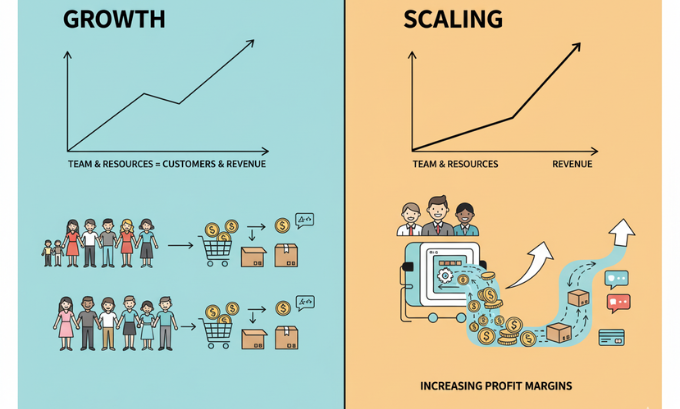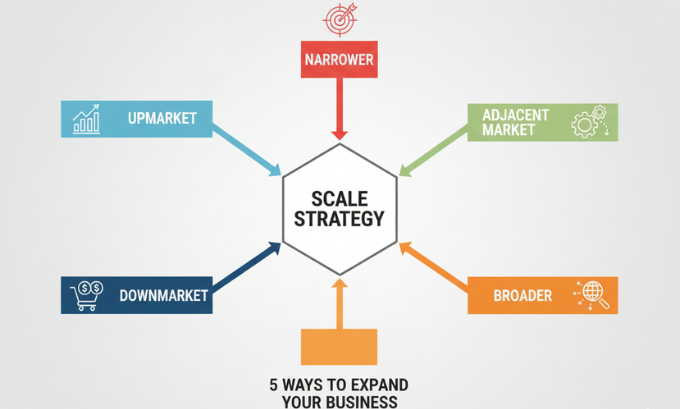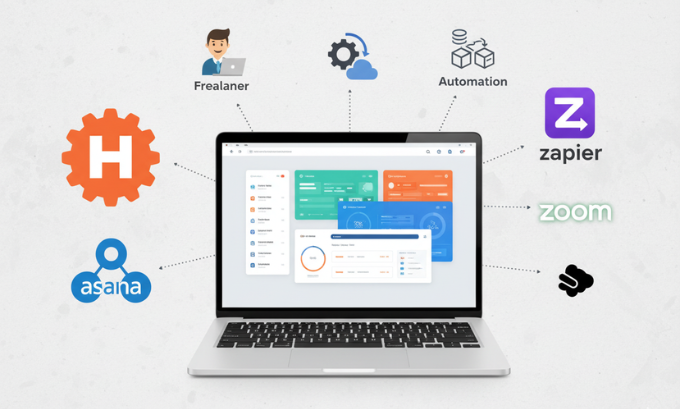Scaling a business is about growing revenue faster than you add resources. It requires more than just hard work; it demands a strategic plan to increase sales, build efficient systems, and assemble the right team. Successfully scaling means creating a repeatable process that allows your company to handle increased demand without being overwhelmed or sacrificing quality.
This guide provides a comprehensive framework for scaling your business. We will explore proven strategies, from defining your market to investing in technology and talent. You will learn from the experiences of successful entrepreneurs and companies, gaining the insights needed to build a durable, profitable, and scalable enterprise.
Table of Contents
The Foundation: Understanding Growth vs. Scaling
To scale a business successfully, you first need to understand the difference between growth and scaling. Growth means adding resources at the same rate you add revenue. For example, if you double your clients, you double your staff and costs. Scaling, on the other hand, is about increasing revenue without a substantial increase in resources.
This is where efficiency comes in. A scalable business model allows you to serve 100 or 1,000 customers with nearly the same operational effort it takes to serve 10. Think of software companies; they can sell their product to millions without rebuilding it for each new user. The key is to build systems and processes that work for you, creating leverage that drives profitability.

Setting SMART Goals for Scalability
- Specific: Clearly define what you want to achieve. Instead of “increase sales,” aim for “increase monthly recurring revenue by 20% in Q4.”
- Measurable: Establish concrete metrics to track your progress.
- Attainable: Set ambitious but realistic targets.
- Relevant: Ensure your goals align with your company’s long-term vision.
- Time-bound: Set a clear deadline to create urgency and focus.
Before you can scale, you need a clear destination. The SMART Goals framework is an essential tool for creating actionable objectives. Your goals must be:
Using SMART Goals turns vague ambitions into a concrete roadmap. For instance, a goal to expand your customer base could be broken down into quarterly milestones for lead generation, conversion rates, and customer acquisition costs. This process provides clarity and keeps your team aligned as you navigate the complexities of scaling.
Choosing Your Path: The 5-Way Scaling Framework
One of the most practical approaches to scaling comes from Alex Hormozi, founder of Acquisition.com. His Scaling Framework outlines five distinct strategic directions a business can take to expand its Total Addressable Market (TAM). The TAM represents the entire revenue opportunity available for your product or service. Understanding these five paths helps you make a conscious decision about how your business will evolve.
Here’s a breakdown of the framework, enriched with real-world scenarios and experiences.

My Experience Applying This Framework
In my first venture, a digital marketing agency, we hit a revenue ceiling. We were serving local small businesses and were great at it, but there were only so many businesses in our city. We were growing, but not scaling. Our costs rose with every new client.
We had to make a strategic choice. Drawing inspiration from Hormozi’s framework, we analyzed our best customers. We found our most profitable and successful clients were mid-sized e-commerce brands. This led us to our scaling move: going narrower and then upmarket. We refined our services specifically for e-commerce, creating a highly specialized and valuable offering. This allowed us to increase our prices and target larger clients nationwide, dramatically expanding our TAM and profitability without proportionally increasing our team size.
What I Like / Strengths of This Approach:
- Clarity: The framework simplifies a complex decision into five clear options.
- Actionable: It forces you to be intentional about your market, rather than drifting.
- Proven: Industry leaders like Salesforce and Microsoft have used these principles to become giants.
- Versatile: It applies to virtually any business, from service agencies to software companies.
Areas for Improvement / Potential Pitfalls:
- Timing is Critical: Moving too quickly, especially going broader, can dilute your value proposition and stretch your resources too thin.
- Requires Deep Customer Insight: Going narrower requires robust data on your most profitable customer segments.
- Execution Risk: Each path has unique challenges. Going upmarket, for example, involves longer sales cycles and more demanding clients.
If you want to know more about scale a business successfully you can read this articles gogonihon.jp.net or mumbaitimes.net
The 5 Strategic Paths to Scale
Here are the five strategies from the Scaling Framework you can use to expand your market and scale your business successfully.
1. Go Upmarket
This strategy involves targeting larger, more sophisticated customers within your industry. Instead of selling to individual hair salons, you target multi-location chains or national franchises. The deals are bigger, the clients are more stable, and churn is typically lower.
- Example: Salesforce started by providing CRM solutions to small and medium-sized businesses. Over time, they moved upmarket to serve enterprise clients, becoming the dominant player in the Fortune 500 space. Similarly, digital marketing experts like Neil Patel and Gary Vaynerchuk (GaryVee) built their empires by offering services to large corporations.
2. Go Downmarket
Going downmarket means targeting the entry-level segment of your industry. If you sell to gyms, you could create a product for individual personal trainers. If you sell to established businesses, you could target aspiring entrepreneurs. This market is vast and full of emotional buyers.
- Challenge: This segment has high churn and can be demanding. Success here depends on excellent, low-touch marketing and sales systems, as the product itself is often less of a factor than the ability to consistently attract new customers.
3. Go to an Adjacent Market
This involves moving into a related vertical. If you serve chiropractors, you could expand to physical therapists. If you work with restaurants, you might target hotels. These markets often share similar problems, allowing you to adapt your core offering with minor adjustments.
- Strategy: Find a “champion” from the adjacent market who can help you adapt your language and product. This is a slower but highly profitable way to grow, as you can extract maximum value from each new vertical you enter.
4. Go Broader
Going broader means generalizing your offering to serve multiple verticals at once. Instead of targeting just “gyms,” you would target the entire “fitness industry,” including boutique studios, yoga centers, and martial arts dojos.
- Trade-off: This move can 10x your TAM overnight, but it makes you a generalist. You will compete with specialists in every niche, and your value proposition may be less potent. This strategy is best pursued after you have already achieved significant scale and expertise in a specific niche.
5. Go Narrower
This counterintuitive strategy involves becoming more specific about who you serve. You don’t just target small businesses; you target “small businesses with over $50k in monthly revenue and at least three employees.”
- Benefit: This approach allows you to focus on your ideal, most profitable customers. By analyzing your top 20% of clients—the ones who get the most value and stay the longest—you can re-engineer your marketing and sales to attract only them. This increases prices, profit margins, and efficiency, making it one of the most powerful moves for businesses earning less than $10 million annually.
As you scale your e-commerce business, sourcing trending and reliable products from a site like TokyoMart.store can give you a competitive edge in new markets.
Comparison of Scaling Strategies
| Strategy | Primary Benefit | Key Challenge | Best For |
|---|---|---|---|
| Go Upmarket | Higher-value deals, lower churn | Long sales cycles, high expectations | Businesses with a proven product and strong case studies. |
| Go Downmarket | Nearly unlimited customer pool | High churn, low-priced offerings | Companies with strong marketing and automated sales funnels. |
| Go Adjacent | Leverage existing expertise | Requires new industry knowledge | Businesses looking for steady, profitable expansion. |
| Go Broader | Massive, immediate TAM expansion | Diluted value proposition, increased competition | Mature businesses that have earned the right to generalize. |
| Go Narrower | Increased profitability and efficiency | Smaller total customer pool | Early-stage businesses seeking to maximize profit and value. |
Building the Engine: Systems and Talent
A clear strategy is just the start. To execute it, you need scalable systems and a talented team. This is where many businesses falter. They add customers faster than their infrastructure can handle, leading to burnout, poor service, and stalled growth.

Investing in Technology and Automation
Technology is the great enabler of scale. Automation tools can handle repetitive tasks, freeing your team to focus on high-impact work.
- CRM Software: Tools like Salesforce or HubSpot are non-negotiable. They manage customer relationships, automate lead nurturing, and provide invaluable data for decision-making.
- Project Management: Asana, Trello, or Monday.com keep your team organized and your projects on track.
- Workflow Automation: Zapier can connect your different apps and automate workflows without writing a single line of code. For example, you can automatically add a new e-commerce customer to your email list and a Slack channel.
Scaling requires optimizing every customer touchpoint—LinkLuminous.com helps you manage, track, and enhance link performance at scale.
Building a Flexible and Talented Team
You cannot scale on your own. However, hiring full-time employees for every new need is often slow and expensive. This is why a hybrid talent model, combining core in-house staff with flexible on-demand professionals, is so effective for scaling companies.
Platforms like Upwork give you instant access to a global pool of skilled talent. Need a motion graphics designer for a marketing campaign? A financial analyst to build a forecasting model? A developer to integrate a new API? You can hire them for a specific project without the overhead of a full-time employee.
This approach lets you stay agile, fill skills gaps quickly, and manage costs effectively. A powerful example is Microsoft, which needed to produce a large volume of high-quality videos on a tight deadline. Instead of hiring a full-time production team, they used Upwork to assemble a team of freelance designers, animators, and editors. They met their ambitious goal on time and under budget, proving the power of a flexible talent strategy.
FAQs: How to Scale a Business Successfully
1. What is the first step to scaling a business?
The first step is to establish a strong foundation with a proven product-market fit and repeatable sales process. Before scaling, ensure your business is stable and you understand your core customer base. Then, use the SMART Goals framework to set clear scaling objectives.
2. How do I know if my business is ready to scale?
Your business is ready to scale if you have consistent demand, positive cash flow, and happy customers who are seeing results. If your existing systems and team are handling the current workload with ease, it may be time to consider strategic expansion.
3. What is the difference between going “upmarket” and going “narrower”?
Going upmarket means targeting a higher class of customer (e.g., small business to enterprise). Going narrower means adding more qualifications to your existing customer profile to find the most ideal version of them (e.g., targeting only the top 20% of your current customer base).
4. How can I fund my business’s scaling efforts?
Funding can come from various sources, including venture capital, angel investors, business loans, or reinvesting profits. The right choice depends on your business model, growth rate, and long-term goals. Attracting investors requires a solid plan, clear financial projections, and a strong pitch deck.
5. Is it better to focus on acquiring new customers or retaining existing ones?
While both are important, scaling profitably often relies on retaining and expanding revenue from existing customers. It is typically 5 to 25 times more expensive to acquire a new customer than to retain an existing one. Upselling, cross-selling, and building loyalty are key scaling levers.
6. What are the biggest mistakes to avoid when scaling?
The biggest mistakes include scaling too soon without a solid foundation, hiring too quickly without a clear need, neglecting company culture, and failing to build scalable systems. Many businesses, as Alex Hormozi notes, also go too broad too soon.
7. How can a platform like Upwork help my business scale?
Upwork provides access to a global network of skilled freelance professionals. This allows you to quickly fill skill gaps, handle project-based work, and scale your workforce up or down as needed without the long-term commitment and costs of hiring full-time employees. This agility is crucial for managing growth effectively.
Conclusion: Your Path to Sustainable Scale
Knowing how to scale a business successfully is not about a single magic bullet. It’s a journey of strategic choices, disciplined execution, and continuous learning. It begins with a deep understanding of your market and a clear vision for the future, guided by frameworks like SMART Goals and the five strategic paths.
Whether you choose to go upmarket like Salesforce, tap into flexible talent like Microsoft, or focus on your ideal customer as advocated by Acquisition.com, the principles remain the same. Build efficient systems, invest in the right people, and never lose sight of the value you provide to your customers.
By applying these strategies, you can move beyond simple growth and build a truly scalable enterprise—one that is not only larger but also stronger, more profitable, and more resilient.
About the Author
This article was written by a team of business strategists and content experts with over a decade of experience helping businesses navigate the challenges of growth and scaling. Our insights are drawn from hands-on work with dozens of companies, from startups to enterprise-level organizations, as well as extensive research into the methodologies of leading industry experts and firms.

